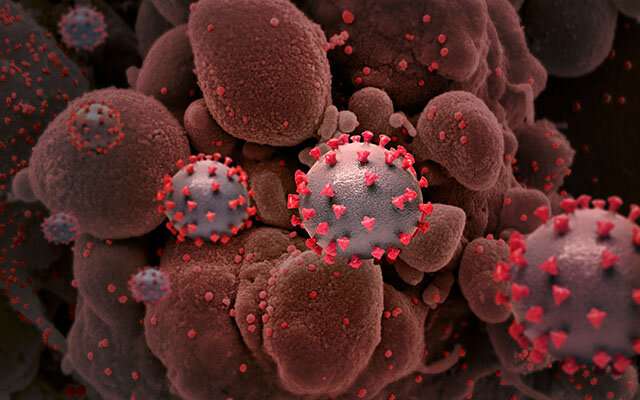A possible mechanism of lymphocyte deficiency in patients with COVID-19

Scientists from RUDN, National Medical Research Centre for Hematology, and Lomonosov Moscow State University have uncovered one of the possible pathogenetic mechanisms of severe lymphopenia in patients with COVID-19. For the first time, they presented evidence of the possibility of direct infection of lymphocytes with SARS-CoV-2 virions. The article was published in the journal Viruses.
Lymphocytes are the main cells of the immune system. Deep lymphopenia (≤1000/µl) is observed in 96% of patients with severe and in 80% of patients with moderate COVID-19. The pathogenesis of lymphopenia in patients with COVID-19 is not fully understood and consists of more than 10 possible mechanisms, extrapulmonary dissemination, and direct effects of SARS-CoV-2 on the tissues of lymphoid organs.
"The objective of the study was to assess viral load and patterns of SARS-Cov-2 dissemination to the lungs, mediastinal lymph nodes, and the spleens of patients with COVID-19 associated lymphopenia", said Igor Babichenko. Doctor of Medicine, Head of the Department of Pathological Anatomy at RUDN University.
Scientists carried out a comprehensive molecular genetic, immunohistochemical, and electron microscopic examination of lung tissues, mediastinal lymph nodes lying along the path of lymph flow from the lungs, and the spleen of 36 patients who died from COVID-19. They detected In 63.8% lymphopenia was detected with a lymphocyte level below the critical value of 1 million cells per ml of blood.
In 33% of patients, the virus was detected in the lungs, with an average viral load of 239. The condition of the cells in these patients indicated bronchopneumonia (acute inflammation of the walls of the bronchioles) and acute respiratory distress syndrome (ARDS) in the proliferative stage when the lungs are restoring (but the shortness of breath and other symptoms persist). In 58.4% of patients, SARS-CoV-2 was detected in the lungs, lymph nodes, and spleen with an average viral of 12,116 in the lungs, 832 in the lymph nodes, and 71.5 in the spleen. This corresponds to the exudative phase of ARDS, when the pulmonary capillaries and alveoli are damaged, gas exchange is disrupted. Immunohistochemical analysis showed the presence of the virus in pulmonary macrophages, epithelial cells of bronchioles, and alveoli. During electron microscopic studies, the scientists for the first time managed to prove the possibility of direct infection of lymphocytes with SARS-CoV-2 particles, which may cause the development of lymphopenia due to massive apoptosis of lymphocytes, previously described in related SARS-CoV and MERS-CoV infections.
"Extrapulmonary dissemination of SARS-CoV-2 in the tissue of the lymphatic organs occurs during the exudative phase of ARDS. It is associated with a shorter period of stay in ICU and higher SARS-CoV-2 virus load in the lung tissues compared with patients with SARS-CoV-2 dissemination limited to the lungs. The finding of a lymphocyte infected with SARS-COV-2 particles, which we first revealed, might indicate that SARS-COV-2 could induce lymphopenia through possible direct cytotoxic effect", said Igor Babichenko. Doctor of Medicine, Head of the Department of Pathological Anatomy at RUDN University.
More information: Adhamjon Abdullaev et al, Viral Load and Patterns of SARS-CoV-2 Dissemination to the Lungs, Mediastinal Lymph Nodes, and Spleen of Patients with COVID-19 Associated Lymphopenia, Viruses (2021). DOI: 10.3390/v13071410



















